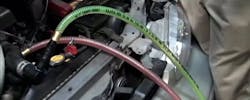The first thing I need to state is that this is not a plumbing discussion. Rather, it deals with a question that many have raised about flushing engines, cooling systems and transmissions. There are many good reasons to flush any of these systems.
New engines run more efficiently, but over time, they gather harmful deposits that cause power and performance loss. Stop-and-go driving, prolonged idling, short trips that do not allow the engine to reach full operating temperature, towing, the ingestion of airborne dirt, fuel dilution, water condensation and oxidized oil all can promote sludge build-up in motors. As it settles, sludge clogs narrow oil passages, restricting oil flow to vital parts, especially the upper valve train area.
In transmissions, deposits can form on clutch plates, causing hesitation and erratic shifting. Ultimately clutch glazing can set in, reducing the life of the transmission. Deposits in engines and transmissions can accelerate wear, causing power loss and increased fuel consumption.
Rust and dirty coolant that circulates in a car’s cooling system can lead to a clogged radiator, resulting in overheating and engine damage. Draining the radiator alone does not sufficiently remove old coolant, as the radiator may contain 40 percent or less of the coolant. Over time, coolant breaks downs and works less effectively to keep the engine cool. This places stress on the radiator and causes the engine to run hotter. Prolonged use of old coolant may result in major radiator and engine damage.
So the question becomes, how can we prolong engine and transmission life. One of the most popular ways is flushing the various systems.
Engine flushes help restore fuel economy, increase operating efficiency and reduce emissions in gasoline and diesel engines. They are additive top-treats, normally added to engine oil prior to draining, and contain detergent-based formulas that clean out sludge and deposit build-up, which help to reduce fuel and oil consumption.
Cleaning up a transmission is a different story. It’s often not practical to drain a transmission due to the way they are designed. The torque converter holds oil that doesn’t drain easily, and there are literally hundreds of nooks and crannies where oil hangs up.
Transmission flushes are accomplished by circulating new fluid throughout the transmission. This carries away the sludge and varnish that collect in all those inaccessible places. Some of these systems periodically take a portion of the flush out and add more new oil until the flush oil looks clean.
Coolant flushes are normally made with water plus a coolant flush additive to clean the oxidized coolant and accumulated rust and scale. The water and flush additive are circulated throughout the coolant system (including passenger compartment heater cores). Once the mix has been circulated and is clean, new coolant/water mix is added to the system.
One of the questions often asked by fast oil change and other vehicle service providers is, “Can I use my flushing fluid on more than one car?” It’s a good question, and there is a simple answer, no. For engine oils it’s pretty simple; the drain oil plus flushing additive is already used up, so dispose of the drain oil and move on.
The transmission drain issue is more complex. An old contact in the transmission fluid business noted that it is not a good idea to reuse the same fluid again and again for flushing. Each flush just gets out a portion of the old fluid and replaces it with a small portion of new fluid. The best way is to drain what you can, add new fluid, circulate and then drain again. A single flush only replaced something like 17 percent at a time, and multiple flushes with fresh fluid were required. New techniques for transmission drains probably are not much different. That is because a lot of service places at dealers are using the ATF flush systems that actually run new fluid into the transmission while pushing through (and out) the old fluid.
When the fluid is circulated, it removes a great deal of sludge and varnish. If it is used on another transmission, the debris and sludge will be pumped into the new transmission. That will result in sticking valves and clutches. It could even degrade the frictional properties of the transmission. The best practice is to dispose of the flushing fluid. One recommendation is to use an engine oil flush additive for transmissions. That’s not a good idea either. The additive system in engine oils is not the same as transmission fluids. It can actually cause problems with clutch surfaces and degrade transmission performance.
Coolant flush is the same as transmission flush. The flushing fluids will pick up a lot of rust and sludge and shouldn’t be used again. It will simply deposit the old debris in a different engine.
The last question to answer is, how often should any of these fluids be exchanged? For engine oils, the change should occur according to the owner’s manual or sooner. As far as flushing is concerned, if oil changes have been on schedule and with the right oil, there shouldn't be sludge buildup, so flushing is probably not useful. If the oil hasn’t been changed often enough or incorrect oil has been used for an application (e.g. on a turbocharged engine), there may be some sludge accumulated. Usually, it accumulates at the top of the engine and tends to stay there.
How about coolant? Many service shops that service cars with "lifetime" coolant, say you should do it more often than the maintenance schedule recommends, such as every 30,000 or 50,000 miles. Most vehicles use long-life engine coolant (usually a 50/50 mixture of antifreeze and water) that will provide protection for several years against boiling in hot weather and freezing in cold weather, with little maintenance. Modern vehicles also have longer intervals between fluid changes of all types, partly because environmental regulators have pressured automakers to reduce the amount of waste fluids that have to be disposed of or recycled.
The transmission gives out some signs that it might need a new fluid flush. They include strange noises or even grinding coming from the transmission, problems shifting gears, some slippage when shifting gears, unexplained surging of the vehicle or delay in movement after placing the vehicle in gear. The general recommendation is to flush the transmission every two years or 30,000 miles.
There’s a whole world of flushes out there. Hopefully, this clears up that world a little.






